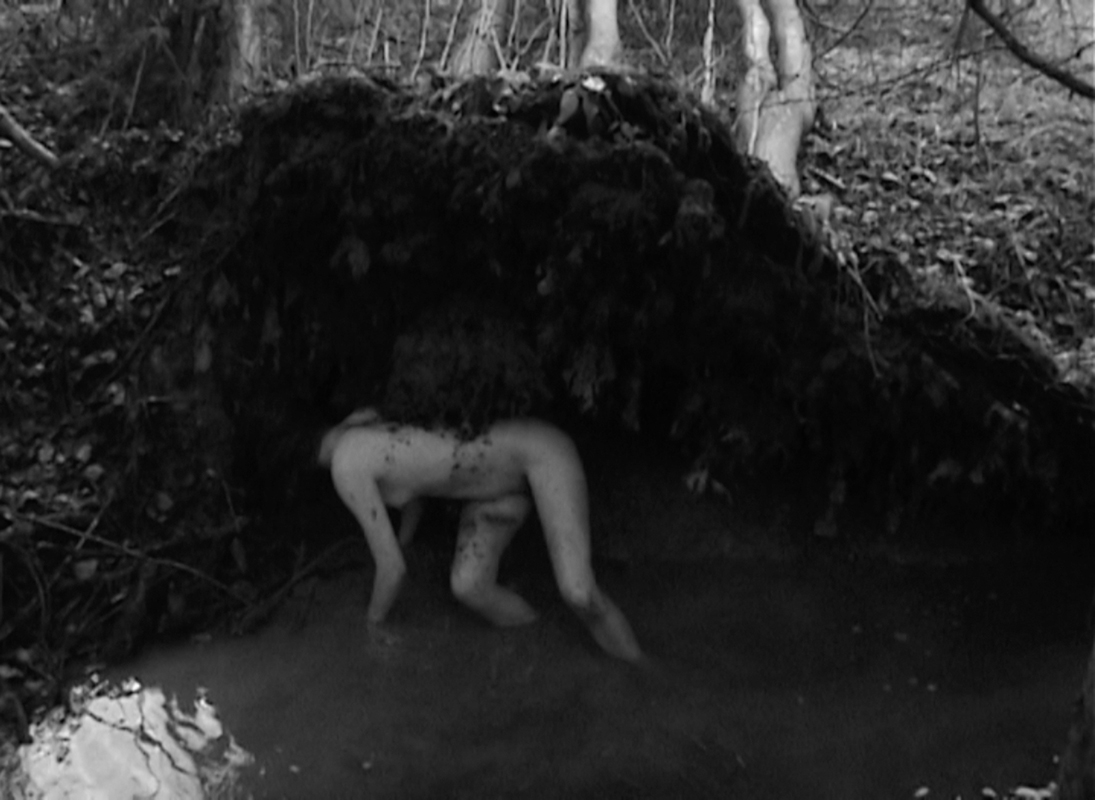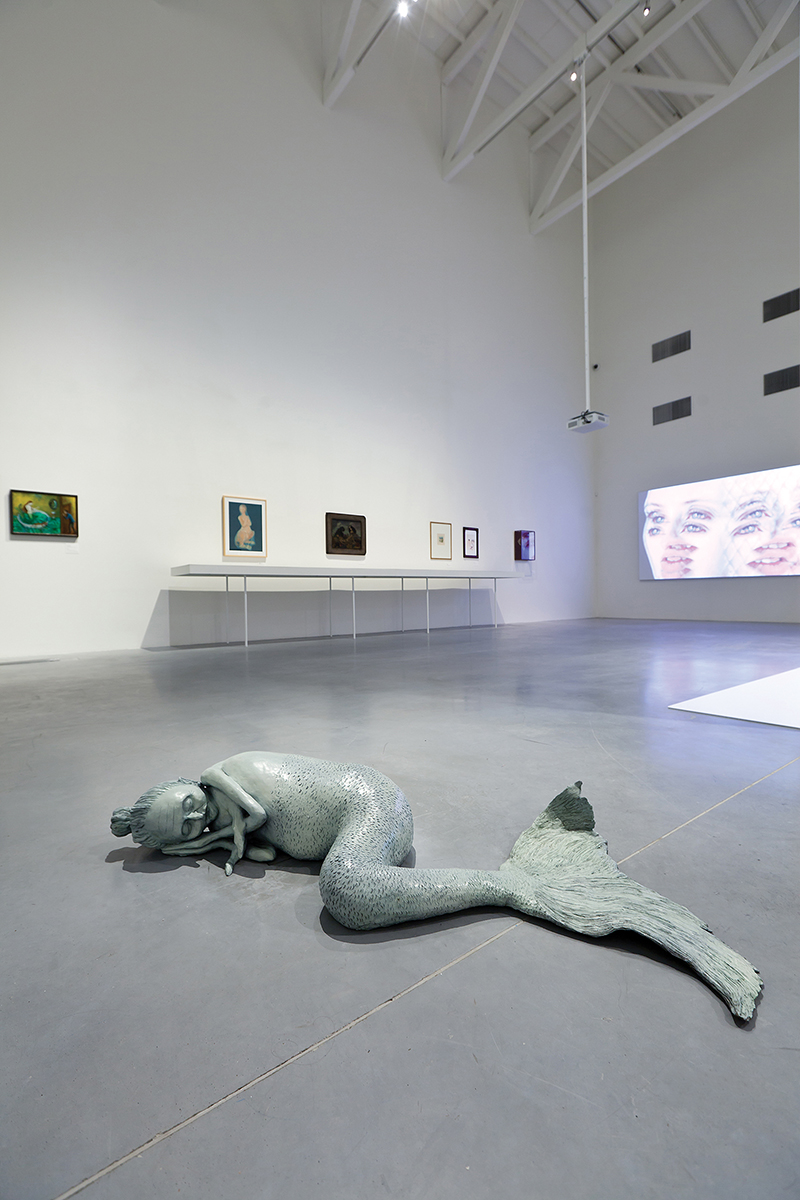I’m Parthenope I call for my sister Syren. Roads are now between us. Roads that rim the Adriatic and cut the Danube into strips. Via Venice the ghost. Vienna a gold stamp. Villach. Vyskov till the Vistula River where she has lived since the age of maps.
The word hybrid originates in the context of livestock. Its Latin antecedent, hibrida, referred to the progeny of a tame sow and a wild boar. Over time, it came to signify a person of mixed parentage. The child of a Roman father and an itinerant mother was a hibrida, as was that of a freeman and a slave. Modern colonialism allowed the word to flourish.1 Hybrid became synonymous with other terms rooted in the creaturely idea of mixed-ness: mulatto, mongrel, half-breed.

A replica of Konstanty Hegel’s Syrenka Warszawska (1855) in the Old Town Square, Warsaw, June 2017. Photo: Cora Gilroy–Ware.
Although they are frequently described as such, mermaids are not hybrids. Rather than being the blended offspring of distinct elements, they are a kind all of their own. Yet the mermaid provides the perfect symbol of hybridity. Her composite form—the head and torso of a woman, the tail of a fish—embodies the same supernatural convergence of human and animal that was mapped onto the hybrid child. From her scales to her hair, she unites the polarities of foreign and familiar, wild and domesticated, beast and beauty. There is also a hybrid aspect to her representation in art and literature. Sirens, the bird-winged seductresses of Greek mythology, have been portrayed as mermaids ever since antiquity.2 As a result, romance languages do not differentiate between feathered and fishtailed maidens; sirena implies mermaid in both Spanish and Italian, sirène in French, sirenă in Romanian. Far more visible in our culture, the aquatic figure has eclipsed the avian girls who attempted to lure Homer’s Odysseus to the rocks.
The same is true in Poland, where syrena is the common word for mermaid. This is an especially important setting, as the heraldic emblem of Warsaw, the nation’s capital, is the syrena herself. In the city’s Old Town Market Place, she holds court in the form of a bronze effigy elevated a few feet above the ground. Here, in the reconstructed quarter of a city that was once devastated by war, we learn that this particular mermaid is not the irresistible, long-haired creature that the word tends to conjure. With sword and shield in hand and tresses pulled back into a knot, the syrena of Warsaw is a warrior. Her latest feat is an exhibition inspired by her image at the Warsaw Museum of Modern Art.

Justyna Górowska, FW JG, 2009–15. Video still. MPEG-4, 720 × 576 px., 15 min. © Justyna Górowska. Courtesy of the artist.
Entitled The Beguiling Siren Is Thy Crest, the exhibition uses the symbolic hybridity of the syrena as its point of departure. Inside a pristinely new exhibition pavilion, portrayals of fishtailed, feathered, furry, and generally bestial female figures proliferate across time and media. The syrena of Warsaw punctuates the display, reining it in when it strays from the theme. Outside, the Vistula river flows by, the syrena’s official home. Along the bank another bronze effigy, younger in age yet bathed in a mint green patina, marks her dominion. The title of the show is lifted from an ode to the city by Cyprian Kamil Norwid, one of Warsaw’s foremost nineteenth century poets. The poem, “Dedykacka” (Dedication, 1866), was written about ten years after Norwid went into self-imposed exile from Poland to Paris, where he eventually died.3 Influenced by the first stirrings of the women’s movement, his verse is suffused with meditations on feminine strength.4
Known as the Museum on the Vistula, the building containing the exhibition was designed by Austrian architect Adolf Krischanitz in 2007. Originally, the oblong structure sat on the Spree River in Berlin, where it was used as a temporary Kunsthalle. After two years in Germany, it was disassembled and loaded onto trucks headed for Warsaw. It was then resurrected in time for The Beguiling Siren Is Thy Crest, its public debut.5 As cities that once were both part of the same empire, Berlin and Warsaw are reunited by the building, which has the clean, classical restraint of a Prussian barrack.

Louise Bourgeois, Untitled, 2007. Ink and pencil on paper, 12½ × 34 in. © The Easton Foundation/Licensed by VAGA, New York. Courtesy of VAGA Inc., New York. Photo: Christopher Burke.
Soon after entering the pavilion, one encounters FW JG (2009–15), a video by contemporary Polish artist Justyna Górowska, wall-mounted on a small screen. In black-and-white, the body of a woman appears, moving in slow motion. Crouching on all fours, she shelters inside a cove formed by upturned tree roots. We cannot see her head, just the geometry of her limbs: light angles against the dark crust of mud, liquid, and tree. As the two sets of initials in the title hint, the video is a tribute to the American photographer Francesca Woodman, whose body Górowska sought to inhabit while filming. To its credit, however, Górowska’s video is less immediately suggestive of Woodman than an invasive wildlife documentary that plants a night vision camera inside the burrow of a mysterious creature and waits for it to emerge. Viewers are plunged into a damp, murky habitat that would otherwise be inaccessible, and in the process become acutely aware of the artificiality of their own environment, especially in an exhibition space as fresh as this one. The video sets the tone for what is to come. It lets us know, from the outset, that The Beguiling Siren Is Thy Crest plays on the fragility of the border between humanity and animal instinct: the poles brought together in the mermaid’s form. Next we find a cluster of works on paper by Louise Bourgeois. Untitled (2007) centers on the outline of a mermaid in ink over horizontal pencil lines. The double linearity of the work articulates the same fragile border. Blood red, the line describing the mermaid’s form is inconsistent, permeable. By contrast, the neat grey marks in the background read like a musical score: the epitome of human achievement designed to keep nature at bay.
I’m Parthenope I call from a bay studded with islands. Capri. Coral and dried lava. Floating filth collected for my crown. Crested with a tincture of cholera. Her crown is new, made after the air stilled. But it looks just like it did when crinolines rustled like oak trees.
Not until further in are we reminded of the exhibition’s muse, the syrena of Warsaw specifically. Another video, this time by Agnieszka Polska, a contemporary Polish artist of the same generation as Górowska, looms on a large screen on the back wall. Made purposely for the exhibition, Ask the Siren (2017) attempts to speak from the syrena’s perspective. A pale face made up of cushiony lips and heavily lashed blue eyes—no nose—is reflected twice across the screen, with one half rippled by scales. Fragments of a monologue spurt from the mouth, captioned with English subtitles: “I hate foreigners. I get sick at the thought of them.” More human than animal, Polska’s 2017 syrena has been caught in the net of fascism, which Klaus Theweleit characterizes as an ideology of extreme opposition to hybridity.6 Intermittently the face is replaced by dystopian shots of the city streets in winter, submerged underwater.

Agnieszka Polska, Ask the Siren, 2017. Video still. HD video, 10:25 min. © Agnieszka Polska. Courtesy of ŻAK | BRANICKA, Berlin.
Polska’s video is a key feature of The Beguiling Siren Is Thy Crest. In the piece, as throughout the exhibition, the syrena and her kind persist as subjects as opposed to objects. Again and again, over the course of the show, identification with such figures recurs. In I Will Survive (2015), a video by Berlin based artist Ming Wong, a group of four men transform themselves into a troop of mermaid-esque beings. Their luxurious, waist-length wigs—each in a different primary color, plus green, with an extra triangle to cover the groin—compensate for their lack of scales. After stripping off starchy white dresses, they frolic naked in a stream, pausing to pose among the rocks like Venus rising from the sea with her attendants, a Greco-Roman scene whose iconography intersects with the mermaid’s.7 Myth becomes a site of freedom. To be the mermaid, the nymph, or the waterborne goddess is to transcend a masculinity structured by reason. Instead of the animalistic dimension of the mermaid, Wong mines the sensuality that was traditionally considered the font of the figure’s power: “the treacherous mermaid,” in the words of Dorothy Dinnerstein, the “seductive and impenetrable female representative of the dark and magic underwater world from which our life comes and in which we cannot live.”8 Identifying with this aspect, Wong reclaims the mermaid’s charged sensuality not for the purposes of seduction but as a universal human right, a way of being in the world, of surviving.

Ming Wong, Aku Akan Bertahan / I Will Survive, 2015. From a series of six Archival Pigment Prints, 31½ × 47 in., Edition 5+2AP. © Ming Wong. Courtesy of the artist, Vitamin Creative Space, Guangzhou and carlier | gebauer, Berlin.
A sculpture by the Los Angeles-based artist Liz Craft encourages a different kind of identification: empathy. Old Maid (2004) consists of a fishtailed figure, close to life size, curled up with her head pillowed on her hands. Does the mermaid age like we mortals do? What might a decayed mermaid look like, and what would be her fate? The closed, quiet composition is opposite to the resplendent gestures of Wong’s troop, who bask in the rays of desire. Placed directly on the ground without a plinth, Craft’s mermaid is striking precisely because she does not invite our gaze. Her torso is a conical lump with no undulating curves; her breasts are like fins. Tucked into fetal position, the figure calls to mind the uncannily elderly quality of a newborn baby. Although also cast in bronze, she looks nothing like the triumphant effigies of the syrena outside the exhibition walls. In these civic works, the hardness of the material suppresses the mermaid’s associations with sex and death. Unbreakable bronze contours serve to reinforce the border between human and animal nature, facilitating the subject’s appropriation into an emblem.9 With Craft’s Old Maid, on the other hand, the metal is treated in such a way that its monumental permanence is altogether denied. The mermaid has a temporality that goes against both the idealizing connotations of figural sculpture and the immortality of the subject in its archetypal guise. It is as if she is shriveling before our eyes.
The theme of identification is especially relevant to the female surrealists, including Dorothea Tanning and Leonor Fini, whose works are afforded a special place in the exhibition. Fini was fixated not on the mermaid but the sphinx, another composite mythological creature. In the Egyptian tradition, the sphinx is androgynous, with a human head and lion haunches.Subsequent Greek adaptations made the sphinx more feminine and mobile, affording her breasts and a set of wings. As a girl in the northern Italian city of Trieste, Fini was captivated by sphinxes. Miramare Castle, the former residence of the Archduke of Austria, was occasionally open to the public. Here, in a garden facing the Adriatic, sat a stone sphinx from Egypt. Later, Fini recalled her reaction to the sculpture: “I remember I wanted to be like the sphinx… I wanted to think like it, to be strong and eternal, to be a living sphinx.”10 One of seven works by Fini on display is The Veiled Sphinx (c. 1974), a lithograph. A lone female figure with lion haunches is placed against a deep green background, her form brought further into relief by the silvery gauze that envelops her. Sphinxes are usually represented in a sitting position; Fini’s figure stands on her hind legs, looking out past the eye of the viewer. Surveying whatever she sees in the distance, she becomes self-conscious and folds her arms to cover her naked human chest. The blue eyes of the figure prevent it from being interpreted as a straightforward self-portrait, as many of Fini’s works are. Yet it is clear that the artist has placed herself in the position of the sphinx. She has fulfilled her childhood dream of becoming the sphinx, but the world beyond the pictorial space does not value the strength of the sculpture at Miramare. In the 1970s, entering the mind of the sphinx, “(thinking) like the sphinx,” brings alienation. The veil provides protection, albeit diaphanous, from the mechanized forces that threaten her mysteries.

Liz Craft, Old Maid, 2004. Bronze, 9 × 53 × 27 in. Collection of Holly and Jonathan Lipton, New York. © Museum of Modern Art in Warsaw. Courtesy of Museum of Modern Art in Warsaw, Warsaw. Photo: Bartosz Stawiarski.
In her 1970 essay, “Female Human Animal,” Fini’s close friend and fellow surrealist Leonora Carrington reflects on the same confrontation between the modern world and mythic nature. She defines technology as “the astute extensions of the human body…hypnotic impressions of man.”11 The future of life on earth, she argues, depends on some kind of rebellion against the growing sovereignty of these “thinking toys.”12 We must return to the “nameless, unknown force” that “operates in the soul,” the same “pre-form of life” that “induced the serpent to grow feathers.”13 The Italian Futurists famously declared: “War is beautiful because it establishes human domination over the subjugated machinery… War is beautiful because it enriches a flowering meadow with the fiery orchids of machine guns.”14 Witnessing the victory of technology over nature in her lifetime, Carrington seeks to restore the authority of organic life. In this struggle, however, there are no guarantees. Flora and fauna owe nothing to humanity; as John Berger writes, nature “lends itself as much to evil as to good. Its energy is fearsomely indifferent.”15 Still, it must be protected against the appropriation of its power, and its beauty, by machines.
The key role given to the original female surrealists in The Beguiling Siren Is Thy Crest locates the exhibition less in Warsaw and more in this abstract zone of resistance. We must remember that these are relatively late works by Fini and Carrington, made long after the heyday of the movement. As such, untouched by fashion and at a distance from the more famous male practitioners with whom their creators are often linked, these works show that surrealists’ political vision was not merely cultural.16 Rooted in the conscious as opposed to the unconscious mind, these works are warnings. Protect your inner sphinx, your animal self, your inner mermaid-warrior, or disappear. The precise location of the show becomes newly relevant and compelling when we consider that the residents of Warsaw who fought back against fascism– the anti-hybrid ideology—may have tapped into a similar spirit.

Leonor Fini, The Veiled Sphinx, 1974. Color lithography on paper. Collection of the Museum of Art in Łódź. © Artist Rights Society (ARS), New York / ADAGP, Paris.
Despite the sterile feel of the space, the exhibition has an erotic dimension. We are left with a sense of interconnectivity, of unity, that overrules the blocks of text that appear every so often to orient the visitor. Unfamiliar names hold their own next to the well established; works by Polish and non-Polish artists flow without interruption; contemporary and historic works are unsegregated; videos, drawings, paintings, prints, and a variety of sculptures come together to form one autonomous creature. Unlike the mermaid, the exhibition is a true hybrid. With its rational lines, the building is the Roman father. The art is the itinerant mother: boundless.
Unspeakable, her tragedies I felt over the roads. Thicker than mine and louder. Heeled boots. Shod hooves clicking slapping on the square. I never thought she’d live like this. Tangled up in mortal dreams as they come and go.
Cora Gilroy-Ware has recently finished a book on politicized representations of the body in nineteenth-century British art. She is currently working on a novel about Greek gods in exile.
